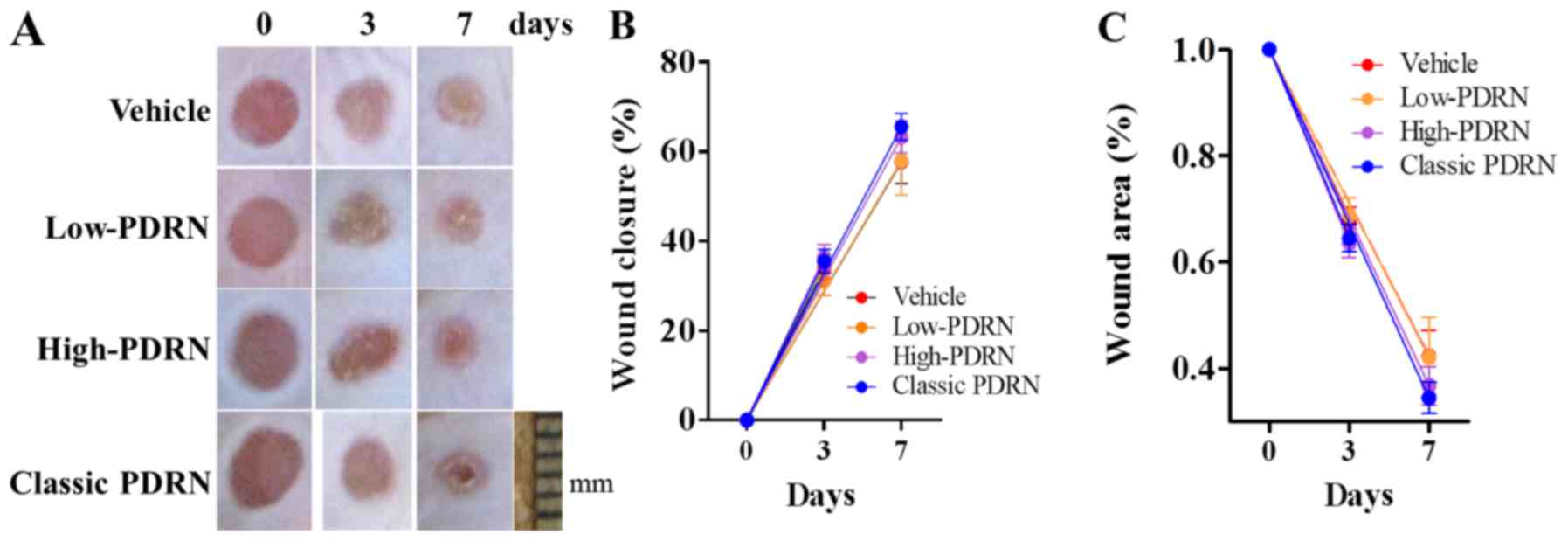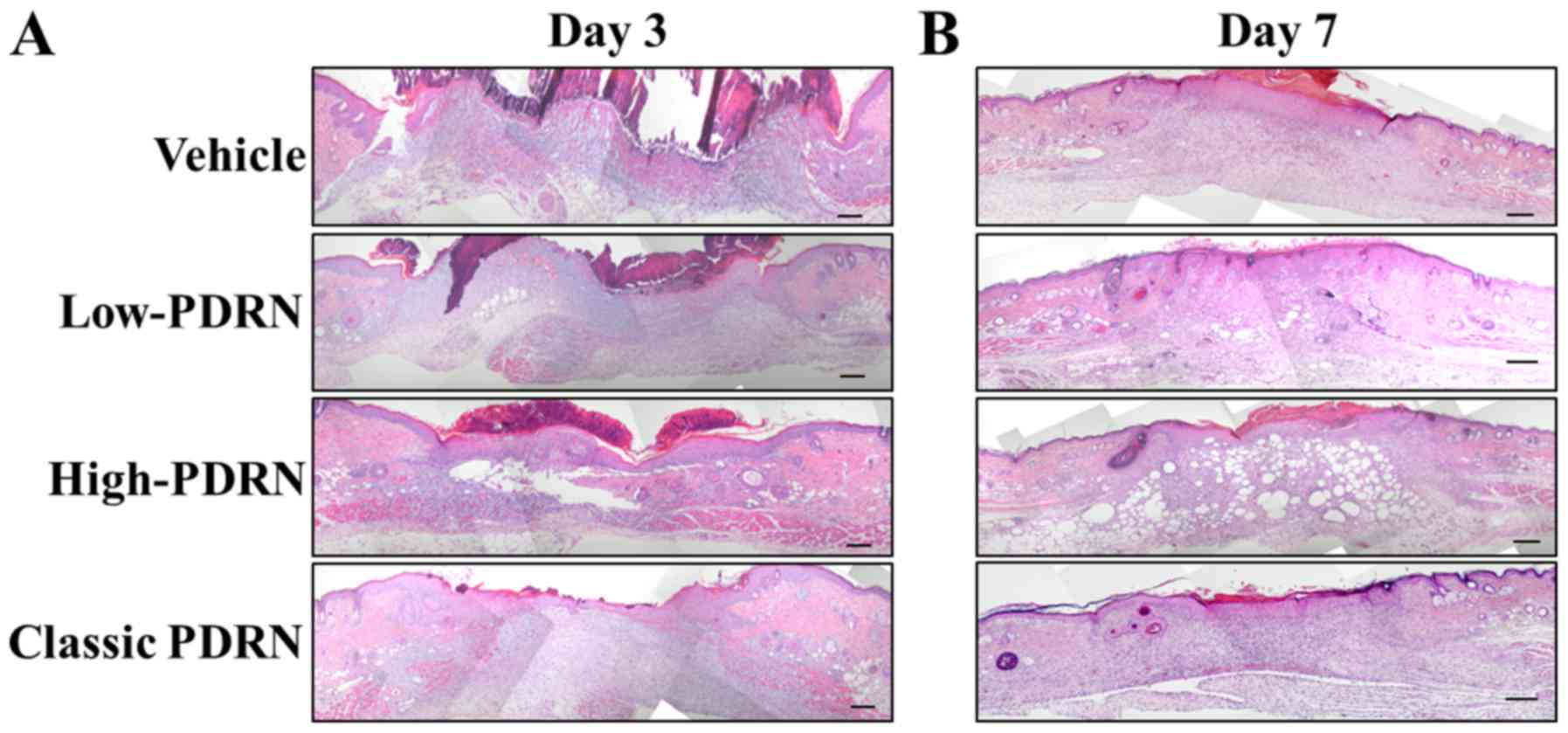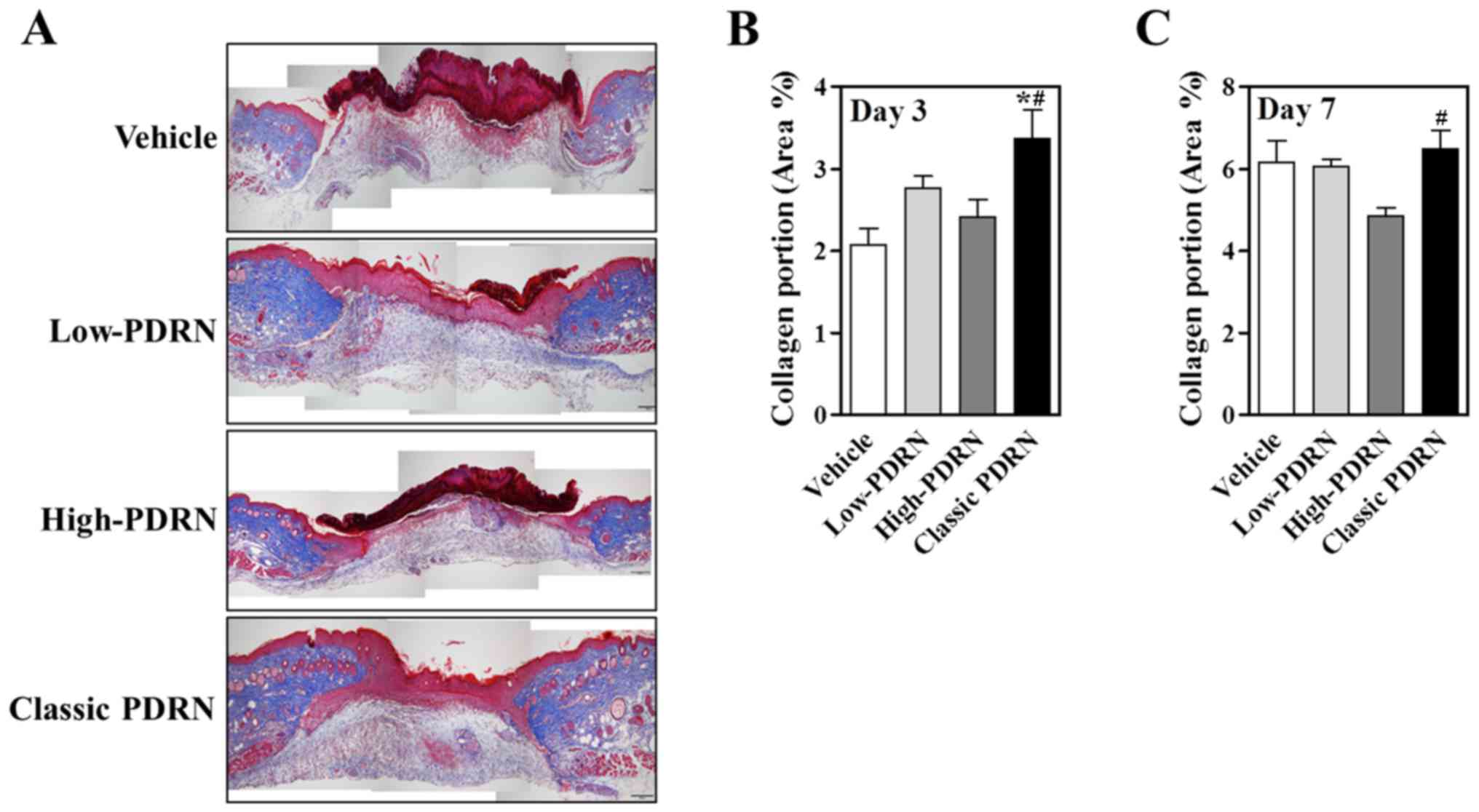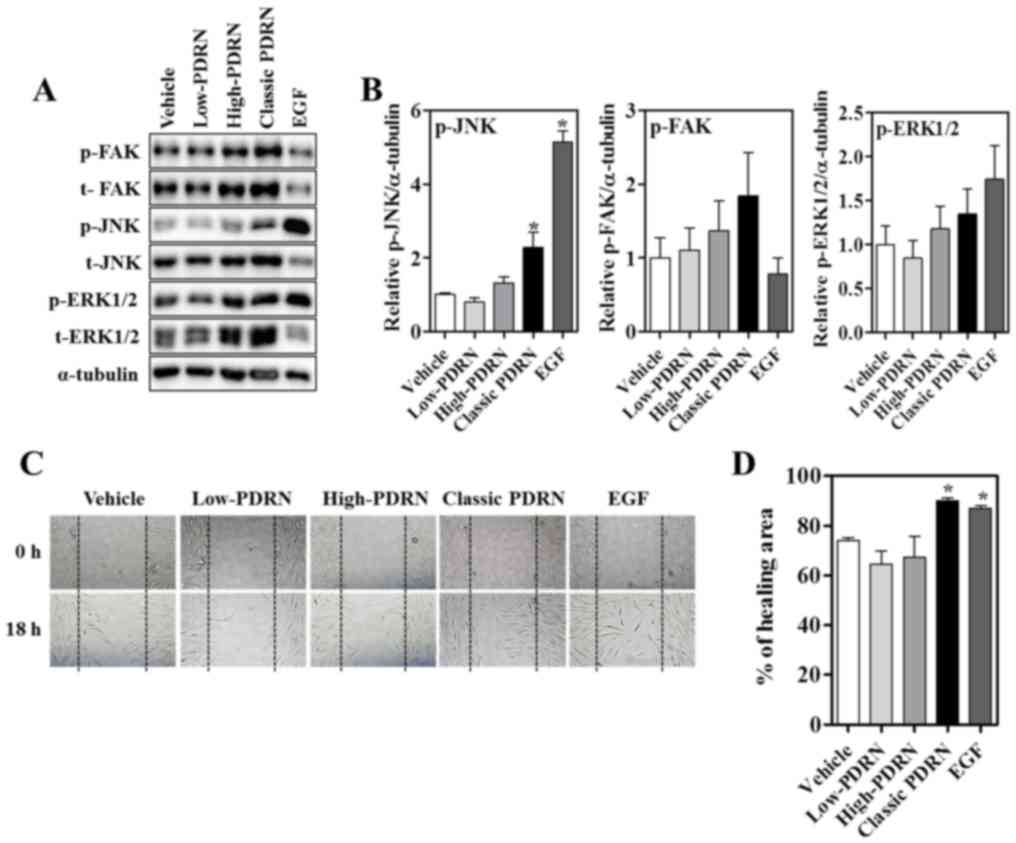|
1
|
Wahl SM, Wong H and McCartney-Francis N:
Role of growth factors in inflammation and repair. J Cell Biochem.
40:193–199. 1989. View Article : Google Scholar : PubMed/NCBI
|
|
2
|
Greenhalgh DG, Sprugel KH, Murray MJ and
Ross R: PDGF and FGF stimulate wound healing in the genetically
diabetic mouse. Am J Pathol. 136:1235–1246. 1990.PubMed/NCBI
|
|
3
|
Gilmore MA: Phases of wound healing.
Dimens Oncol Nurs. 5:32–34. 1991.PubMed/NCBI
|
|
4
|
Yu A, Niiyama H, Kondo S, Yamamoto A,
Suzuki R and Kuroyanagi Y: Wound dressing composed of hyaluronic
acid and collagen containing EGF or bFGF: Comparative culture
study. J Biomater Sci Polym Ed. 24:1015–1026. 2013. View Article : Google Scholar : PubMed/NCBI
|
|
5
|
Tonello G, Daglio M, Zaccarelli N,
Sottofattori E, Mazzei M and Balbi A: Characterization and
quantitation of the active polynucleotide fraction (PDRN) from
human placenta, a tissue repair stimulating agent. J Pharm Biomed
Anal. 14:1555–1560. 1996. View Article : Google Scholar : PubMed/NCBI
|
|
6
|
Galeano M, Bitto A, Altavilla D, Minutoli
L, Polito F, Calò M, Lo Cascio P, Stagno d'Alcontres F and
Squadrito F: Polydeoxyribonucleotide stimulates angiogenesis and
wound healing in the genetically diabetic mouse. Wound Repair
Regen. 16:208–217. 2008. View Article : Google Scholar : PubMed/NCBI
|
|
7
|
Altavilla D, Squadrito F, Polito F, Irrera
N, Calò M, Lo Cascio P, Galeano M, La Cava L, Minutoli L, Marini H
and Bitto A: Activation of adenosine A2A receptors restores the
altered cell-cycle machinery during impaired wound healing in
genetically diabetic mice. Surgery. 149:253–261. 2011. View Article : Google Scholar : PubMed/NCBI
|
|
8
|
Bitto A, Polito F, Altavilla D, Minutoli
L, Migliorato A and Squadrito F: Polydeoxyribonucleotide (PDRN)
restores blood flow in an experimental model of peripheral artery
occlusive disease. J Vasc Surg. 48:1292–1300. 2008. View Article : Google Scholar : PubMed/NCBI
|
|
9
|
Squadrito F, Bitto A, Irrera N, Pizzino G,
Pallio G, Minutoli L and Altavilla D: Pharmacological activity and
clinical use of PDRN. Front Pharmacol. 8:2242017. View Article : Google Scholar : PubMed/NCBI
|
|
10
|
Veronesi F, Dallari D, Sabbioni G, Carubbi
C, Martini L and Fini M: Polydeoxyribonucleotides (PDRNs) from skin
to musculoskeletal tissue regeneration via adenosine A2A
receptor involvement. J Cell Physiol. 232:2299–2307. 2017.
View Article : Google Scholar : PubMed/NCBI
|
|
11
|
Thellung S, Florio T, Maragliano A,
Cattarini G and Schettini G: Polydeoxyribonucleotides enhance the
proliferation of human skin fibroblasts: Involvement of A2
purinergic receptor subtypes. Life Sci. 64:1661–1674. 1999.
View Article : Google Scholar : PubMed/NCBI
|
|
12
|
Valdatta L, Thione A, Mortarino C, Buoro M
and Tuinder S: Evaluation of the efficacy of
polydeoxyribonucleotides in the healing process of autologous skin
graft donor sites: A pilot study. Curr Med Res Opin. 20:403–408.
2004. View Article : Google Scholar : PubMed/NCBI
|
|
13
|
Lee SH, Zheng Z, Kang JS, Kim DY, Oh SH
and Cho SB: Therapeutic efficacy of autologous platelet-rich plasma
and polydeoxyribonucleotide on female pattern hair loss. Wound
Repair Regen. 23:30–36. 2015. View Article : Google Scholar : PubMed/NCBI
|
|
14
|
Yoon YC, Lee DH, Lee MY and Yoon SH:
Polydeoxyribonucleotide injection in the treatment of chronic
supraspinatus tendinopathy: A case-controlled, retrospective,
comparative study with 6-month follow-up. Arch Phys Med Rehabil.
98:874–880. 2017. View Article : Google Scholar : PubMed/NCBI
|
|
15
|
Squadrito F, Bitto A, Altavilla D,
Arcoraci V, De Caridi G, De Feo ME, Corrao S, Pallio G, Sterrantino
C, Minutoli L, et al: The effect of PDRN, an adenosine receptor A2A
agonist, on the healing of chronic diabetic foot ulcers: Results of
a clinical trial. J Clin Endocrinol Metab. 99:E746–E753. 2014.
View Article : Google Scholar : PubMed/NCBI
|
|
16
|
De Caridi G, Massara M, Acri I, Zavettieri
S, Grande R, Butrico L, de Franciscis S and Serra R: Trophic
effects of polynucleotides and hyaluronic acid in the healing of
venous ulcers of the lower limbs: A clinical study. Int Wound J.
13:754–758. 2016. View Article : Google Scholar : PubMed/NCBI
|
|
17
|
Kim S, Kim J, Choi J, Jeong W and Kwon S:
Polydeoxyribonucleotide improves peripheral tissue oxygenation and
accelerates angiogenesis in diabetic foot ulcers. Arch Plast Surg.
44:482–489. 2017. View Article : Google Scholar : PubMed/NCBI
|
|
18
|
Jeong W, Yang CE, Roh TS, Kim JH, Lee JH
and Lee WJ: Scar prevention and enhanced wound healing induced by
polydeoxyribonucleotide in a rat incisional wound-healing model.
Int J Mol Sci. 18:pii: E1698. 2017. View Article : Google Scholar
|
|
19
|
Polito F, Bitto A, Galeano M, Irrera N,
Marini H, Calò M, Squadrito F and Altavilla D:
Polydeoxyribonucleotide restores blood flow in an experimental
model of ischemic skin flaps. J Vasc Surg. 55:479–488. 2012.
View Article : Google Scholar : PubMed/NCBI
|
|
20
|
Lee JH, Han JW, Byun JH, Lee WM, Kim MH
and Wu WH: Comparison of wound healing effects between
Oncorhynchus keta-derived polydeoxyribonucleotide (PDRN) and
Oncorhynchus mykiss-derived PDRN. Arch Craniofac Surg.
19:20–34. 2018. View Article : Google Scholar : PubMed/NCBI
|
|
21
|
Jeon JW, Lee JI, Shin HP, Cha JM, Joo KR,
Kim SH, Ko IG, Jin JJ, Kim SE and Kim CJ: Adenosine
A2A-receptor agonist polydeoxyribonucleotide promotes
gastric ulcer healing in Mongolian gerbils. Anim Cells Syst.
18:399–406. 2014. View Article : Google Scholar
|
|
22
|
Bohn G, Liden B, Schultz G, Yang Q and
Gibson DJ: Ovine-based collagen matrix dressing: Next-generation
collagen dressing for wound care. Adv Wound Care (New Rochelle).
5:1–10. 2016. View Article : Google Scholar : PubMed/NCBI
|
|
23
|
Kajanne R, Miettinen P, Mehlem A, Leivonen
SK, Birrer M, Foschi M, Kähäri VM and Leppä S: EGF-R regulates MMP
function in fibroblasts through MAPK and AP-1 pathways. J Cell
Physiol. 212:489–497. 2007. View Article : Google Scholar : PubMed/NCBI
|
|
24
|
Gazel A, Banno T, Walsh R and Blumenberg
M: Inhibition of JNK promotes differentiation of epidermal
keratinocytes. J Biol Chem. 281:20530–20541. 2006. View Article : Google Scholar : PubMed/NCBI
|
|
25
|
Mitra SK, Hanson DA and Schlaepfer DD:
Focal adhesion kinase: in command and control of cell motility. Nat
Rev Mol cell Biol. 6:56–68. 2005. View
Article : Google Scholar : PubMed/NCBI
|
|
26
|
Jeong EK, Jang HJ, Kim SS, Lee SY, Oh MY,
Kim HJ, Eom DW, Ham JY and Han DJ: Protective effect of
polydeoxyribonucleotide against renal ischemia-reperfusion injury
in mice. Transplant Proc. 48:1251–1257. 2016. View Article : Google Scholar : PubMed/NCBI
|
|
27
|
Kim JY, Pak CS, Park JH, Jeong JH and Heo
CY: Effects of polydeoxyribonucleotide in the treatment of pressure
ulcers. J Korean Med Sci. 29 Suppl 3:S222–S227. 2014. View Article : Google Scholar : PubMed/NCBI
|
|
28
|
Bitto A, Polito F, Irrera N, D'Ascola A,
Avenoso A, Nastasi G, Campo GM, Micali A, Bagnato G, Minutoli L, et
al: Polydeoxyribonucleotide reduces cytokine production and the
severity of collagen-induced arthritis by stimulation of adenosine
A(2A) receptor. Arthritis Rheum. 63:3364–3371. 2011.
View Article : Google Scholar : PubMed/NCBI
|
|
29
|
Buffoli B, Favero G, Borsani E, Boninsegna
R, Sancassani G, Labanca M, Rezzani R, Nocini PF, Albanese M and
Rodella LF: Sodium-DNA for bone tissue regeneration: An
experimental study in rat calvaria. Biomed Res Int.
2017:73209532017. View Article : Google Scholar : PubMed/NCBI
|
|
30
|
Noh TK, Chung BY, Kim SY, Kim SY, Lee MH,
Kim MJ, Youn CS, Lee MW and Chang SE: Novel anti-melanogenesis
properties of polydeoxyribonucleotide, a popular wound healing
booster. Int J Mol Sci. 17:14482016. View Article : Google Scholar :
|
|
31
|
Bao P, Kodra A, Tomic-Canic M, Golinko MS,
Ehrlich HP and Brem H: The role of vascular endothelial growth
factor in wound healing. J Surg Res. 153:347–358. 2009. View Article : Google Scholar : PubMed/NCBI
|
|
32
|
Stevens LJ and Page-McCaw A: A secreted
MMP is required for reepithelialization during wound healing. Mol
Biol Cell. 23:1068–1079. 2012. View Article : Google Scholar : PubMed/NCBI
|
|
33
|
Bitto A, Oteri G, Pisano M, Polito F,
Irrera N, Minutoli L, Squadrito F and Altavilla D: Adenosine
receptor stimulation by polynucleotides (PDRN) reduces inflammation
in experimental periodontitis. J Clin Periodontol. 40:26–32. 2013.
View Article : Google Scholar : PubMed/NCBI
|
|
34
|
Guizzardi S, Galli C, Govoni P, Boratto R,
Cattarini G, Martini D, Belletti S and Scandroglio R:
Polydeoxyribonucleotide (PDRN) promotes human osteoblast
proliferation: A new proposal for bone tissue repair. Life Sci.
73:1973–1983. 2003. View Article : Google Scholar : PubMed/NCBI
|
|
35
|
Belletti S, Uggeri J, Gatti R, Govoni P
and Guizzardi S: Polydeoxyribonucleotide promotes cyclobutane
pyrimidine dimer repair in UVB-exposed dermal fibroblasts.
Photodermatol Photoimmunol Photomed. 23:242–249. 2007. View Article : Google Scholar : PubMed/NCBI
|


















